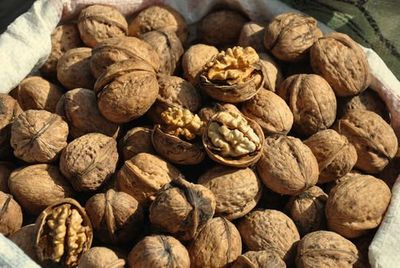Can butterfly-shaped walnuts be eaten?
Butterflying walnuts is the deterioration of the normally firm and full structure of the walnut kernel, taking on a loose form and sometimes taking on a powdery appearance. This situation can occur as a result of improper storage of walnuts or keeping them for a long time. Humidity, temperature changes and contact with air can cause walnuts to deteriorate over time and thus become deformed.
The fact that a walnut is butterflied does not mean that it is directly poisonous or harmful to health. However, caution should be exercised before consuming it. In order to understand whether butterflied walnuts are safe to consume, the following criteria should be taken into consideration:

If the butterflied walnut is not completely spoiled and there are no symptoms mentioned above, it may not pose a major health risk other than a slightly stale taste. So, can butterflied walnuts be eaten? The answer to this question depends on the situation. If there is only a slight butterflied sign on the walnut and the harmful organisms inside have been cleaned, it may be possible to consume it in some cases. However, if there is mold, a bad smell or a bitter taste on the walnut, it should definitely not be consumed. Mold can produce harmful substances, especially aflatoxin, and these toxins can lead to serious health problems.
However, when moldy or oxidized walnuts are consumed, stomach upsets, food poisoning and health problems related to toxins can be seen. Whether or not butterflied walnuts can be consumed depends on the degree of spoilage. If there is severe spoilage, bad smell or mold in the walnut, it should definitely not be consumed. However, if there is only slight butterflied and there is no bad taste or smell, it can be consumed after careful cleaning. The healthiest and safest option is to always consume fresh and properly stored walnuts.
Moldy walnuts can produce harmful substances called aflatoxins, which can cause serious health problems in the long term. Instead of consuming walnuts that are not completely spoiled but slightly stale, it is possible to use them in different ways:

Butterfly walnuts are not always unconsumable, but they should be carefully checked before consumption. If there are signs of spoilage such as odor, taste or color change, they should definitely not be consumed. Walnuts stored under appropriate storage conditions can be consumed healthily by preserving their freshness for a longer period of time. Storing walnuts in dry, cool and airtight containers will help prevent the walnuts from spoiling.
First of all, it is important to understand why walnuts become butterfly-shaped. When walnuts are not stored under appropriate conditions, moisture can form inside them, which can lead to the reproduction of harmful microorganisms or insects. In addition, if there are cracks in the outer shell of the walnut, it is easier for small larvae to enter. These larvae develop over time and create the condition called butterfly-shaped inside the walnut.
To prevent walnuts from going butterfly-like, proper storage conditions should be observed. Storing walnuts in cool, dry, airtight containers can prevent insects and moisture from entering. Additionally, storing walnuts in the refrigerator or freezer will help preserve their freshness.
Habertürk






